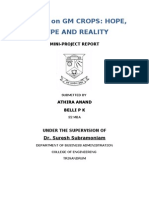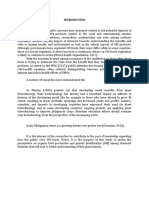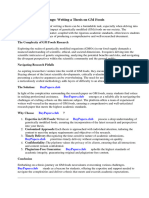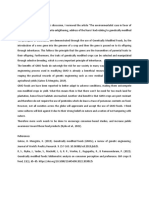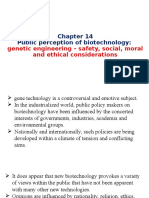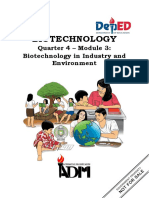Professional Documents
Culture Documents
Awareness of Grade 9 Students in Genetically Modified Organisms (GMO) Food Products A Survey Study
Original Title
Copyright
Available Formats
Share this document
Did you find this document useful?
Is this content inappropriate?
Report this DocumentCopyright:
Available Formats
Awareness of Grade 9 Students in Genetically Modified Organisms (GMO) Food Products A Survey Study
Copyright:
Available Formats
Volume 7, Issue 7, July – 2022 International Journal of Innovative Science and Research Technology
ISSN No:-2456-2165
Awareness of Grade 9 Students in Genetically
Modified Organisms (GMO) Food Products:
A Survey Study
Richelle C. Castro
Bulacan State University
City of Malolos, Bulacan
Abstract:- There are many modifications and advancing stock of human knowledge [4]. The field of Science
advancements that happen in different fields. Science is not is not an exemption to the effects of technological innovations
an exemption for it is always partnered with technology. because it is the theoretical factor of the technology which is
One of the recent innovations in the field of Genetics are the application of the concepts.
the genetically modified organisms (GMOs) which are very
controversial for its positive and negative effects to the One of the domains of science is genetics. According to
health of the consumers, existence of stronger pests, and Encyclopædia Britannica, Inc., genetics is the investigation of
economic effects. This study aims to collect the general heredity and genes in specific. Genetics composes one of the
awareness and perception of Grade 9 students of a state main pillars of biology and is connected with many other areas,
laboratory high school about the Genetically Modified including agriculture, medicine, plant biology, and
Organism (GMO) products. This paper displays that the biotechnology. Genetics, which is the study of heredity, is a
23 Grade 9 student participants from a state laboratory field also influenced by technology.
high school batch 2021-2022. The male is 30.43% of the
respondents’ sex and the female constitutes 69.57% of the Recently, there is much modernism that happens in the
participants. Moreover, the age range of the participants field of genetics. Genetically modified organisms (GMOs) are
is 13-16 years old. Qualitative research method was formed by inserting genetic material, which can be from
utilized through survey questionnaires via Google Forms. another species, into a plant so that the new genetic material
The study was conducted on December 22, 2021. In will induce the plant's ability to display a desirable trait. It
conclusion, there is a lack of awareness of the Genetically enhances the traditional genetic breeding that may produce a
Modified Organism (GMO) products in terms of Basic variety of food animals and plant crops produce for human
knowledge about GMOs, and GMO products effects on consumption. Moreover, the FAO (Food and Agriculture
human health. Organization of the United Nations) and the European
Commission define a GMO as a product “not occurring
Keywords:- GMO, awareness, survey, high school students naturally by mating and/or natural recombination”. GM foods
pertain to foods produced from genetically modified plants or
I. INTRODUCTION animals.
We live on an ever-changing planet Earth which is There are positive and negative feedbacks in this
affected by both the natural processes and the effect of human innovation. Studies show that GMO- opposers are more
interventions on their environment. It is our concern to observe focused on the issue by expressing emotions and blunting
and study our planet’s behavior [1]. Technology improves scientific evidence, while GMO-fanatics stress scientific
almost all aspects of our lives. Now, the existing Industry 4.0 evidence [5].
which is also known as the fourth industrial revolution can help
to fulfill the needs of humanity. This change has started with Some of the positive effects of genetic modification are
the applications of more advanced manufacturing and digital agronomic benefits, economic benefits, modification of the
information technologies [2]. Technology inevitably invades chemical composition in food, improvement in food
these three aspects: social, economic, and environmental processing, and products for therapeutic purposes.
aspects. In terms of communication, economics, education,
politics, and the agricultural sector can also be improved or Under the agronomic benefits is what happened between
degraded by technology [3]. 1996 to 2012. There was an increase of 370 million tons of food
crops. In the United States, one-seventh of the increased yield
The fast-paced modifications are also affecting the is credited to GM crops. Approximately, an addition of more
scientific realm. Advancing technology is the permissive than 300 million acres of conventional crops would have been
source of growth, but it is only a potential, not self-sufficient. needed to have an equal increase in yield as delivered by GM
If technology will be employed widely and efficiently, if its crops.
progress is to be stimulated by such use, institutional and
ideological adjustments must be made to take effect by the
IJISRT22JUL838 www.ijisrt.com 1077
Volume 7, Issue 7, July – 2022 International Journal of Innovative Science and Research Technology
ISSN No:-2456-2165
Moreover, economic benefits from (GM) crops are also There is a need to educate consumers about the health
undeniable. Between 2006 and 2012, farm income had a global benefits and safety of GMO foods, the effective marketing of
increase from GM food of $116 billion which is almost triple GMO foods to the consumers' agricultural producers,
that of the previous 10 years. According to the estimations of distributors, and food retailers. This study uses a sample of
James and Brookes, 42% of the economic gain was from the Grade 9 Junior High School students' awareness about GMO
increased yield due to advanced genetics and resistance to pests foods in terms of characteristics commonly associated with
and weeds. While the remaining 58% was contributed to the organic food, namely healthy, safe, environmentally beneficial,
decreased costs of production including the reduced pesticide and ethical [8]. This research will determine the level of
and herbicide usage. awareness of the students about GMO foods.
The modification of the chemical composition in food II. METHODS
includes some genetic modification that is specifically targeted
to enhance certain nutrient levels for the foods to have high The research instruments used were composed of 10
therapeutic and pro-health value. Some examples are vitamins multiple choice items composed of different aspects of
A, C, E, unsaturated fatty acids, and probiotics. Another awareness, safety, and the consumers’ likelihood to buy a
example is the “Golden Rice” which reduces malnutrition GMO food product from a local market. The respondents
effectively and economically. In the same way, researchers can voluntarily participated in answering the questionnaire on
also change the amino acid composition of proteins and the December 22, 2021. The 23 participants ranging in age from 13
carbohydrate content of foods. to 16 years old are composed of Grade 9 students in a state
university in Bulacan Batch 2021-2022. The primary focus of
Facilitate food processing can also be integrated with the paper is to have an overview of the awareness and
genetic modifications. In 1992, the “Flavr Savr” tomatoes were perception of the Grade 9 students about a trending and relevant
produced by the California company, Calgene. The genetic topic to science which is the Genetically Modified Organism
changes consist of the introduction of an antisense gene, which (GMO) Food Products.
conceals the enzyme polygalacturonase. It will result in
slowing down the ripening of tomatoes and allow longer shelf III. RESULTS
life. The composition in potatoes has also been changed by
gene editing. potatoes display greater stability of brightness
Gender Frequency Percentage
factors and a more attractive appearance using a cyclodextrin
glycosyltransferases gene from bacteria. Male 7 30.43%
Female 16 69.57%
On the other hand, this genetic modification may lead to Total 23 100%
adverse consequences. Also, the scientific community and Table 1:- Gender of the Participants
nonscientists do not agree with this technological intervention
for a variety of reasons. Since the mid-1990s, genetically Table 1 shows that the seven respondents are male while
modified organisms (GMOs) which have huge commercial the remaining 16 participants are female. Male composes
importance have been at the center of political controversy in 30.43% of the respondents and female constitutes 69.57% of
the European Union (EU). Moreover, the number of EU the participants.
member states with a negative stand about GMOs has grown
continuously [6]. In August 2013, anti-GMO (Genetically Age Frequency Percentage
Modified Organisms) activists besieged a research field of 13 1 4.345%
Golden Rice administered by the Philippine International Rice 14 16 69.57%
Research Institute (IRRI), and other sector partners. In July
15 5 21.74%
2011, an attack happened at an experimental farm of the
16 1 4.345%
Commonwealth Scientific and Industrial Research
Total 23 100%
Organization (CSIRO), an Australian federal government
agency for scientific research. A group of protesters from Table 2:- Age Distribution of The Participants
Greenpeace, a non-government, environmental organization
tried to destroy the entire crop of genetically modified wheat in The table 2 exhibits the age distribution of the respondents to
the experimental farm. As an example, genetically altered the survey questionnaire.There are 16 students (60.57%) who
pesticide-resistant crops become the reason for the existence of are 14 years old. One learner is a 13-year-old participant,and
the “pesticide genes to pest species. It then resulted in the another is a 16-year-old participant who composes 4.345% of
development of pesticide-resistant superweeds and increased learners, each. The five students are 15 years old which
contamination of the environment with the pesticide chemicals composes 21.74% of the participants.
that have adverse effects on useful insects [7].
Here are the graphs which show the results from the 10
questions in the survey questionnaire.
IJISRT22JUL838 www.ijisrt.com 1078
Volume 7, Issue 7, July – 2022 International Journal of Innovative Science and Research Technology
ISSN No:-2456-2165
A. General Opinion about GMOs information but would like to gain more information about
Genetically Modified Organisms (GMOs) and Genetically
Modified (GM) products. The 35% of the participants do not
have sufficient information about GMOs and GM products.
While the remaining 4% are constituted by the participants who
have enough information about GMOs and GM products.
Fig. 1:- Opinion Of Respondents About GMOs
Fig. 1 shows the distribution of answers of the
respondents about their general opinion about Genetically
Modified Organisms (GMOs). According to fig. 1, the majority
(52%) of the answers are neutral about GMOs. 26% of the
respondents is composed of the positive opinion about GMOs.
Then, negative opinion dominates in 4% of the participants Fig. 4:- Source Of Information Of Respondents
while 18% have not heard about GMOs.
Fig. 4 graph highlights the responses of the participants
relevant to their source of media where they mostly acquire
information about Genetically Modified Organisms (GMOs).
This pie graph clearly illustrates the distribution of the
responses regarding the media source where they get
information about Genetically Modified Organisms (GMOs).
The majority of the Grade 9 students who participated in this
study found information about GMOs from the internet. The
remaining 9% of the participants were able to garner
information about GMOs from the scientific literature. And the
4% of the respondents have gained additional knowledge about
Fig. 2:- Tendency Of Participants To Buy GMO Products
GMOs through watching T.V. while the other 4% of the
learners have not heard the term GMO before this study.
The Fig. 2 illustration exhibits the percentage distribution
of the responses regarding their likelihood to buy or purchase a
GMO item from a local grocery store. In fig. 2, it was shown
that the majority of the respondents are likely to buy GMO
products from a local grocery store. 31% of them are unlikely
to buy any GMO product from a local store while the remaining
4% of the respondents are very unlikely to purchase a GMO
containing product.
B. Information Acquisition about GMOs
Fig. 5 Participants’ Priority Information About GMOs
Fig. 5 graph analyzes the participants’ answers regarding
the question: “In your opinion, what kind of information about
GMOs would be the most important?” Based on the graph in
Fig. 5, most of the grade 9 participants are valuing the
information about the impact of GMOs on human health. The
other 22% are much interested in the information about GMO
plants in agriculture e.g., GM plants that are grown in the
Fig 3:- Awareness Of Respondents About GMOs Philippines. Moreover, 13% or three participants were engaged
with the idea of the information about up-to-date scientific
Fig. 3 has a pie graph which displays the distribution of achievements in creating and applying GMOs in various areas,
the awareness of the respondents to the Genetically Modified e.g. protection of the environment. The 4% of the participants
Organism (GMO) and Genetically Modified (GM) products. want to know more about GMO usage in medicine and
The majority of the respondents (61%) know a little pharmacy.
IJISRT22JUL838 www.ijisrt.com 1079
Volume 7, Issue 7, July – 2022 International Journal of Innovative Science and Research Technology
ISSN No:-2456-2165
C. Basic knowledge about GMOs Fig. 8 pie graph showcases the perception of the grade 9
level students about the safety of the consumers of GMO food
products. Of all the participants, 12 learners of 65% of the
participants agreed that Genetically Modified (GM) products
have an impact on human health. The remaining 22% do not
know if there is any health impact from GMOs. While 13%of
the respondents believe that there are no impacts to the health
when GMOs were consumed.
Fig. 6:- Differentiation of GM Plants from Normal Ones
Fig. 6 pie graph calculates the participants’ responses regarding
the question: “In your opinion, do Genetically Modified (GM)
plants differ from traditional ones?” According to Fig. 6, there
is 57% percent of the participants agreed the GM plants are
bigger than traditional ones. Out of 23 participants, 7 agreed
that GM plants are not attacked by pests. The remaining 13%
believe that there is no difference between GM plants and
natural ones.
Fig. 9:- GMOs Effect To Genes
Fig. 9 illustration presents the distribution of the
responses about the effect of the consumption of Genetically
Modified (GM) foods on the consumer’s genes. Fig. 9
showcases the opinion of the students regarding the possibility
of the alteration of the genes after consuming Genetically
Modified (GM) foods. The majority of the participants
responded that they do not know if there are possibilities of
gene alteration after consuming GM foods. The 44% of the
participants do not agree with the statement of possible gene
Fig. 7:- Genes of GMOs alteration due to GM food consumption while the remaining
4% of the learners ticked the true answer showing that they
Fig. 7 reveals a basic knowledge of the participants about agree with the statement.
the difference between non-genetically modified soybeans that
do not contain genes and genetically modified soybeans. The
results from fig. 7 show that 57% of the respondents do not
know the difference between non-genetically modified
soybeans that do not contain genes and genetically modified
soybeans. 30% of the participants have agreed that there is a
difference between these two soybeans. While 13% of the
participants disagreed with the statement about the difference
between the two soybeans.
D. Basic GMO products effect to human health
Fig. 10:- Safeness Of GM Foods
Fig. 10 chart represents the responses about the safety and
risk from GM foods usage. Based on Fig. 10, there are 48% of
the respondents chose neither as their response to the question:
How safe or risky are GM foods to human health? 22% of the
participants do not know the answer. According to the
remaining 17% of the respondents, GM foods are very safe
while 13% of the participants believe that GM foods are very
risky to human health.
Fig. 8:- Effect Of GMOs To Human Health
IJISRT22JUL838 www.ijisrt.com 1080
Volume 7, Issue 7, July – 2022 International Journal of Innovative Science and Research Technology
ISSN No:-2456-2165
IV. DISCUSSION [5]. Pillaud, V., Cavazza, N., & Butera, F. (2013). The social
value of being ambivalent: Self-presentational concerns
A. Conclusion in the expression of attitudinal ambivalence. Personality
As a conclusion, this research shows that the 23 Grade 9 and Social Psychology Bulletin, 39(9), 1139-1151.
student participants from a state university high school Batch [6]. Ansell, C., Maxwell, R., & Sicurelli, D. (2006).
2021-2022 have a lack of awareness of the Genetically Protesting food: NGOs and political mobilization in
Modified Organism (GMO) products in terms of Basic Europe. What’s the beef, 97-122.
knowledge about GMOs, and GMO products effects on human [7]. Dar, S. A., Wani, A. B., & Kandoo, A. A. (2017). Genetic
health. The male is 30.43% of the respondents’ sex and the engineering and insect resistance. Journal of Entomology
female constitutes 69.57% of the participants. Moreover, the and Zoology Studies, 5(3), 1175-1184.
age range of the participants is 13-16 years old. [8]. Linnhoff, S., Volovich, E., Russell, H., & Smith, M.
(2017). An examination of millennials’ attitudes toward
B. Recommendations genetically modified organism (GMO) foods: Is it
The future studies will provide additional information Franken-food or super-food?. International Journal of
which may determine the level of awareness of the students Agricultural Resources, Governance and Ecology, 13(4),
about the Genetically Modified Organism (GMO) products. 371-390.
Interventions and teaching methodologists must also be applied
to enhance the awareness of the students regarding these GMO
products. These are some of the recommendations:
1. The replication studies are needed to evaluate how the
learners perceive the Genetically Modified Organism
(GMO) products.
2. More random samples and different kinds of sampling
techniques should be executed to gather more data about
this topic.
3. Further studies should focus on the integration of the topic
of Genetically Modified Organisms (GMO) products in
Science subjects.
ACKNOWLEDGEMENT
The author would like to thank the Bulacan State
University Graduate School for giving an opportunity to write
this paper. Special thanks to Sir Edwin R. Tadiosa for guiding
the researcher in crafting this study. Also, to all the participants,
sections 9-Banzon and 9-Campos, the author wants to express
sincere gratitude for their cooperation.
REFERENCES
[1]. Board, S. S., & National Academies of Sciences,
Engineering, and Medicine. (2019). Thriving on our
changing planet: A decadal strategy for Earth
observation from space. National Academies Press.J.
Clerk Maxwell, A Treatise on Electricity and
Magnetism, 3rd ed., vol. 2. Oxford: Clarendon, 1892,
pp.68-73.
[2]. Javaid, M., Haleem, A., Vaishya, R., Bahl, S., Suman, R.,
& Vaish, A. (2020). Industry 4.0 technologies and their
applications in fighting COVID-19 pandemic. Diabetes
& Metabolic Syndrome: Clinical Research & Reviews,
14(4), 419-422.K. Elissa, “Title of paper if known,”
unpublished.
[3]. Wu, J., Guo, S., Huang, H., Liu, W., & Xiang, Y. (2018).
Information and communications technologies for
sustainable development goals: state-of-the-art, needs
and perspectives. IEEE Communications Surveys &
Tutorials, 20(3), 2389-2406.
[4]. Kuznets, S. (1973). Modern economic growth: findings
and reflections. The American economic review, 63(3),
247-258.
IJISRT22JUL838 www.ijisrt.com 1081
You might also like
- Biotechnology and Genetic Engineering: Revolutionizing the Present and BeyondFrom EverandBiotechnology and Genetic Engineering: Revolutionizing the Present and BeyondNo ratings yet
- A Study On GM CROPS Hope Hype N RealityDocument11 pagesA Study On GM CROPS Hope Hype N RealityBelli P KNo ratings yet
- Research PG2Document15 pagesResearch PG2Jerome ManriqueNo ratings yet
- Genetically Modified Plants and Human Health: Authors: Suzie Key Julian K-C Ma Pascal MW DrakeDocument11 pagesGenetically Modified Plants and Human Health: Authors: Suzie Key Julian K-C Ma Pascal MW DrakeMeryl Jan SebomitNo ratings yet
- Argumentative Essay Research PaperDocument5 pagesArgumentative Essay Research PaperJadNo ratings yet
- Gmo and Health Risks Selected IssuesDocument10 pagesGmo and Health Risks Selected IssuesSkittlessmannNo ratings yet
- FP and Risk Factors GmoDocument12 pagesFP and Risk Factors GmoShaina Marie CabreraNo ratings yet
- Genetic Modification Analysis: Health Hazards Outweigh AdvantagesDocument6 pagesGenetic Modification Analysis: Health Hazards Outweigh AdvantagesOmr MNo ratings yet
- Research Paper On Genetically Modified CropsDocument4 pagesResearch Paper On Genetically Modified Cropsqhujvirhf100% (1)
- Ethical Concerns in Development, Research and Consumption of Genetically Engineered CropsDocument6 pagesEthical Concerns in Development, Research and Consumption of Genetically Engineered CropsMuchamad Bagus SNo ratings yet
- Gmo DissertationDocument5 pagesGmo DissertationHelpWithYourPaperAurora100% (1)
- STS BSA 1-1 Morallos, Jherjhon C.Document3 pagesSTS BSA 1-1 Morallos, Jherjhon C.Jherjhon MorallosNo ratings yet
- The Article dis-WPS OfficeDocument7 pagesThe Article dis-WPS Officegeorginho kingsNo ratings yet
- Research Paper On GMO (CAMALLA & SALUDES)Document6 pagesResearch Paper On GMO (CAMALLA & SALUDES)Julius SaludesNo ratings yet
- Research Paper On Genetically Modified FoodsDocument7 pagesResearch Paper On Genetically Modified Foodssuw1vadibys2100% (1)
- Genetically Engineered Food Research PaperDocument8 pagesGenetically Engineered Food Research Paperh01zpf0p100% (1)
- Impacts of GMOs on Philippine AgricultureDocument3 pagesImpacts of GMOs on Philippine AgricultureIrish Cheska EspinosaNo ratings yet
- Concept Paper 1Document8 pagesConcept Paper 1Darlene YololaNo ratings yet
- Thesis Statement For Genetically Modified FoodsDocument6 pagesThesis Statement For Genetically Modified FoodsCustomPaperWritingServiceSingapore100% (2)
- Project GmosDocument12 pagesProject Gmosapi-609943857No ratings yet
- Impacts of GMOs in the PhilippinesDocument5 pagesImpacts of GMOs in the PhilippinesLeo Sandy Ambe Cuis100% (1)
- ChaptersDocument64 pagesChaptersJay-ann DegulacionNo ratings yet
- Literature Review Genetically Modified FoodDocument6 pagesLiterature Review Genetically Modified Foodafdtzwlzd100% (1)
- FNH 455 Opinion PaperDocument8 pagesFNH 455 Opinion PaperMichelle AhmadiNo ratings yet
- Gmo Research Paper ExampleDocument6 pagesGmo Research Paper Exampleafeavbrpd100% (1)
- Research Paper Topics On Genetically Modified FoodDocument4 pagesResearch Paper Topics On Genetically Modified Foodkbcymacnd100% (1)
- Are Genetically Modified Foods Safe?Document4 pagesAre Genetically Modified Foods Safe?Lindy Lorraine AsidoyNo ratings yet
- ICSA STUDENTS' GMO AWARENESSDocument41 pagesICSA STUDENTS' GMO AWARENESSLA MendozaNo ratings yet
- GM Food Research PaperDocument8 pagesGM Food Research Paperafnkhujzxbfnls100% (1)
- Genetically Modified Foods and Social ConcernsDocument8 pagesGenetically Modified Foods and Social ConcernsLeika GonzalesNo ratings yet
- 1 OnlineDocument7 pages1 Onlinesuyinyinsein.456789No ratings yet
- Research Paper On Gmo FoodsDocument6 pagesResearch Paper On Gmo Foodsn0nijitynum3100% (1)
- VIVIAN SEMINAR Genetically Modified FoodDocument28 pagesVIVIAN SEMINAR Genetically Modified FoodDavid AdenowoNo ratings yet
- EVS (GMF Solo PDF 3rd Sem)Document5 pagesEVS (GMF Solo PDF 3rd Sem)Rajarshi HoreNo ratings yet
- Genetically Food ResearchDocument8 pagesGenetically Food ResearchVeronica YamatNo ratings yet
- Genetically Modified Food and Consumer Purchase Intentions: A Study in Johor Bahru Kamariah IsmailDocument11 pagesGenetically Modified Food and Consumer Purchase Intentions: A Study in Johor Bahru Kamariah IsmailDeEpaa ManohanNo ratings yet
- 2 Introduction BiotechnologyDocument1 page2 Introduction BiotechnologyJordanFinezNo ratings yet
- GM Food Literature ReviewDocument7 pagesGM Food Literature Reviewc5s4gda0100% (1)
- Research Paper GM FoodsDocument7 pagesResearch Paper GM Foodsfvffv0x7100% (1)
- Gmo Research Paper OutlineDocument7 pagesGmo Research Paper Outlinewtdcxtbnd100% (1)
- Biotechnology: Benefit or Risk? The Future of HumanityDocument5 pagesBiotechnology: Benefit or Risk? The Future of HumanityChichiri NomiNo ratings yet
- Assessment of Benefits and Risk of Genetically ModDocument29 pagesAssessment of Benefits and Risk of Genetically ModSkittlessmannNo ratings yet
- GMO Food Preference and Risk Factor (Affirmative)Document8 pagesGMO Food Preference and Risk Factor (Affirmative)Adrian Martinez OdascoNo ratings yet
- Research Paper Over GM FoodsDocument8 pagesResearch Paper Over GM Foodsafmcwqkpa100% (1)
- Week 4 DiscussionDocument1 pageWeek 4 DiscussionIfeomachukwu OdiliNo ratings yet
- Genetically Modified Foods (Gmos) A Review of Genetic EngineeringDocument8 pagesGenetically Modified Foods (Gmos) A Review of Genetic EngineeringPrincess UmipigNo ratings yet
- Public Perception of Biotechnology:: Genetic Engineering - Safety, Social, Moral and Ethical ConsiderationsDocument18 pagesPublic Perception of Biotechnology:: Genetic Engineering - Safety, Social, Moral and Ethical ConsiderationsHayderNo ratings yet
- Position Paper. Gmo FoodsDocument3 pagesPosition Paper. Gmo FoodsJOHN CLARK VILLALOBOSNo ratings yet
- Bio (Ma)Document18 pagesBio (Ma)Shrigith SNo ratings yet
- CH 14Document6 pagesCH 14HayderNo ratings yet
- Gmo Ess Essay 1000 EditedDocument4 pagesGmo Ess Essay 1000 EditedJimmy KudiNo ratings yet
- Figure 1. Sustainable Development GoalsDocument7 pagesFigure 1. Sustainable Development GoalsJihan PacerNo ratings yet
- Essay2 BioAgrDocument1 pageEssay2 BioAgrProsenjit BoseNo ratings yet
- Gmo EssayDocument5 pagesGmo Essayapi-604802402No ratings yet
- Issues and Opinions: Food Biotechnology: Benefits and ConcernsDocument7 pagesIssues and Opinions: Food Biotechnology: Benefits and ConcernsLee BiRonNo ratings yet
- ScienceDocument4 pagesSciencelee heeseungNo ratings yet
- GM Food (IB MYP Essay)Document10 pagesGM Food (IB MYP Essay)Trippin OnAcidNo ratings yet
- Causes and Effects of GM FoodDocument6 pagesCauses and Effects of GM FoodLam ChanNo ratings yet
- Science and Policy For Modern BiotechnologyDocument22 pagesScience and Policy For Modern BiotechnologyEjigayehu DesalegnNo ratings yet
- Genetics LantionDocument3 pagesGenetics LantionAlexandraNo ratings yet
- Diabetic Retinopathy Stage Detection Using CNN and Inception V3Document9 pagesDiabetic Retinopathy Stage Detection Using CNN and Inception V3International Journal of Innovative Science and Research TechnologyNo ratings yet
- Exploring the Molecular Docking Interactions between the Polyherbal Formulation Ibadhychooranam and Human Aldose Reductase Enzyme as a Novel Approach for Investigating its Potential Efficacy in Management of CataractDocument7 pagesExploring the Molecular Docking Interactions between the Polyherbal Formulation Ibadhychooranam and Human Aldose Reductase Enzyme as a Novel Approach for Investigating its Potential Efficacy in Management of CataractInternational Journal of Innovative Science and Research TechnologyNo ratings yet
- Investigating Factors Influencing Employee Absenteeism: A Case Study of Secondary Schools in MuscatDocument16 pagesInvestigating Factors Influencing Employee Absenteeism: A Case Study of Secondary Schools in MuscatInternational Journal of Innovative Science and Research TechnologyNo ratings yet
- An Analysis on Mental Health Issues among IndividualsDocument6 pagesAn Analysis on Mental Health Issues among IndividualsInternational Journal of Innovative Science and Research TechnologyNo ratings yet
- Harnessing Open Innovation for Translating Global Languages into Indian LanuagesDocument7 pagesHarnessing Open Innovation for Translating Global Languages into Indian LanuagesInternational Journal of Innovative Science and Research TechnologyNo ratings yet
- The Utilization of Date Palm (Phoenix dactylifera) Leaf Fiber as a Main Component in Making an Improvised Water FilterDocument11 pagesThe Utilization of Date Palm (Phoenix dactylifera) Leaf Fiber as a Main Component in Making an Improvised Water FilterInternational Journal of Innovative Science and Research TechnologyNo ratings yet
- Advancing Healthcare Predictions: Harnessing Machine Learning for Accurate Health Index PrognosisDocument8 pagesAdvancing Healthcare Predictions: Harnessing Machine Learning for Accurate Health Index PrognosisInternational Journal of Innovative Science and Research TechnologyNo ratings yet
- The Relationship between Teacher Reflective Practice and Students Engagement in the Public Elementary SchoolDocument31 pagesThe Relationship between Teacher Reflective Practice and Students Engagement in the Public Elementary SchoolInternational Journal of Innovative Science and Research TechnologyNo ratings yet
- The Making of Object Recognition Eyeglasses for the Visually Impaired using Image AIDocument6 pagesThe Making of Object Recognition Eyeglasses for the Visually Impaired using Image AIInternational Journal of Innovative Science and Research TechnologyNo ratings yet
- Design, Development and Evaluation of Methi-Shikakai Herbal ShampooDocument8 pagesDesign, Development and Evaluation of Methi-Shikakai Herbal ShampooInternational Journal of Innovative Science and Research Technology100% (3)
- Dense Wavelength Division Multiplexing (DWDM) in IT Networks: A Leap Beyond Synchronous Digital Hierarchy (SDH)Document2 pagesDense Wavelength Division Multiplexing (DWDM) in IT Networks: A Leap Beyond Synchronous Digital Hierarchy (SDH)International Journal of Innovative Science and Research TechnologyNo ratings yet
- Terracing as an Old-Style Scheme of Soil Water Preservation in Djingliya-Mandara Mountains- CameroonDocument14 pagesTerracing as an Old-Style Scheme of Soil Water Preservation in Djingliya-Mandara Mountains- CameroonInternational Journal of Innovative Science and Research TechnologyNo ratings yet
- The Impact of Digital Marketing Dimensions on Customer SatisfactionDocument6 pagesThe Impact of Digital Marketing Dimensions on Customer SatisfactionInternational Journal of Innovative Science and Research TechnologyNo ratings yet
- Formulation and Evaluation of Poly Herbal Body ScrubDocument6 pagesFormulation and Evaluation of Poly Herbal Body ScrubInternational Journal of Innovative Science and Research TechnologyNo ratings yet
- Electro-Optics Properties of Intact Cocoa Beans based on Near Infrared TechnologyDocument7 pagesElectro-Optics Properties of Intact Cocoa Beans based on Near Infrared TechnologyInternational Journal of Innovative Science and Research TechnologyNo ratings yet
- Comparatively Design and Analyze Elevated Rectangular Water Reservoir with and without Bracing for Different Stagging HeightDocument4 pagesComparatively Design and Analyze Elevated Rectangular Water Reservoir with and without Bracing for Different Stagging HeightInternational Journal of Innovative Science and Research TechnologyNo ratings yet
- Auto Encoder Driven Hybrid Pipelines for Image Deblurring using NAFNETDocument6 pagesAuto Encoder Driven Hybrid Pipelines for Image Deblurring using NAFNETInternational Journal of Innovative Science and Research TechnologyNo ratings yet
- Review of Biomechanics in Footwear Design and Development: An Exploration of Key Concepts and InnovationsDocument5 pagesReview of Biomechanics in Footwear Design and Development: An Exploration of Key Concepts and InnovationsInternational Journal of Innovative Science and Research TechnologyNo ratings yet
- A Survey of the Plastic Waste used in Paving BlocksDocument4 pagesA Survey of the Plastic Waste used in Paving BlocksInternational Journal of Innovative Science and Research TechnologyNo ratings yet
- Hepatic Portovenous Gas in a Young MaleDocument2 pagesHepatic Portovenous Gas in a Young MaleInternational Journal of Innovative Science and Research TechnologyNo ratings yet
- Explorning the Role of Machine Learning in Enhancing Cloud SecurityDocument5 pagesExplorning the Role of Machine Learning in Enhancing Cloud SecurityInternational Journal of Innovative Science and Research TechnologyNo ratings yet
- Cyberbullying: Legal and Ethical Implications, Challenges and Opportunities for Policy DevelopmentDocument7 pagesCyberbullying: Legal and Ethical Implications, Challenges and Opportunities for Policy DevelopmentInternational Journal of Innovative Science and Research TechnologyNo ratings yet
- Automatic Power Factor ControllerDocument4 pagesAutomatic Power Factor ControllerInternational Journal of Innovative Science and Research TechnologyNo ratings yet
- Navigating Digitalization: AHP Insights for SMEs' Strategic TransformationDocument11 pagesNavigating Digitalization: AHP Insights for SMEs' Strategic TransformationInternational Journal of Innovative Science and Research TechnologyNo ratings yet
- Studying the Situation and Proposing Some Basic Solutions to Improve Psychological Harmony Between Managerial Staff and Students of Medical Universities in Hanoi AreaDocument5 pagesStudying the Situation and Proposing Some Basic Solutions to Improve Psychological Harmony Between Managerial Staff and Students of Medical Universities in Hanoi AreaInternational Journal of Innovative Science and Research TechnologyNo ratings yet
- Mobile Distractions among Adolescents: Impact on Learning in the Aftermath of COVID-19 in IndiaDocument2 pagesMobile Distractions among Adolescents: Impact on Learning in the Aftermath of COVID-19 in IndiaInternational Journal of Innovative Science and Research TechnologyNo ratings yet
- A Review: Pink Eye Outbreak in IndiaDocument3 pagesA Review: Pink Eye Outbreak in IndiaInternational Journal of Innovative Science and Research TechnologyNo ratings yet
- Drug Dosage Control System Using Reinforcement LearningDocument8 pagesDrug Dosage Control System Using Reinforcement LearningInternational Journal of Innovative Science and Research TechnologyNo ratings yet
- The Effect of Time Variables as Predictors of Senior Secondary School Students' Mathematical Performance Department of Mathematics Education Freetown PolytechnicDocument7 pagesThe Effect of Time Variables as Predictors of Senior Secondary School Students' Mathematical Performance Department of Mathematics Education Freetown PolytechnicInternational Journal of Innovative Science and Research TechnologyNo ratings yet
- Formation of New Technology in Automated Highway System in Peripheral HighwayDocument6 pagesFormation of New Technology in Automated Highway System in Peripheral HighwayInternational Journal of Innovative Science and Research TechnologyNo ratings yet
- توفلDocument20 pagesتوفلqulmanyNo ratings yet
- Didier Montet, R.C. Ray - Aquaculture Microbiology and Biotechnology, Vol. 1 (2009, Science Publishers) PDFDocument274 pagesDidier Montet, R.C. Ray - Aquaculture Microbiology and Biotechnology, Vol. 1 (2009, Science Publishers) PDFMst Pany100% (1)
- Food, Farms, and Solidarity by Chaia HellerDocument52 pagesFood, Farms, and Solidarity by Chaia HellerDuke University PressNo ratings yet
- EuropaBio Guide To GM Crops 2017 - 0 1 2Document64 pagesEuropaBio Guide To GM Crops 2017 - 0 1 2Berat GerguriNo ratings yet
- Biotechnology PP - Genetic Engineering - RDDocument36 pagesBiotechnology PP - Genetic Engineering - RDFlavia CirielloNo ratings yet
- Finals ReviewerDocument20 pagesFinals Reviewerrc.david.florendoNo ratings yet
- Week 4-5Document4 pagesWeek 4-5janice alquizar100% (1)
- SOAL-Soal UNBK Bahasa InggrisDocument5 pagesSOAL-Soal UNBK Bahasa InggrisAbd-ul Mun-imNo ratings yet
- Module 3 Biotechnology q4 Biotechnology in Industry and Environment .Revised PilotDocument34 pagesModule 3 Biotechnology q4 Biotechnology in Industry and Environment .Revised PilotLol NoNo ratings yet
- Agricultural Resource BaseDocument34 pagesAgricultural Resource BaseVenus AnteroNo ratings yet
- Business Ethics Week 1 AssigmentDocument4 pagesBusiness Ethics Week 1 AssigmentSilvio Noel GutierrezNo ratings yet
- Response To A Question On The Order Paper - Media MonitoringDocument1,379 pagesResponse To A Question On The Order Paper - Media MonitoringScott HarrisNo ratings yet
- Transgenic GuidelineDocument12 pagesTransgenic GuidelineYogesh BanginwarNo ratings yet
- GMOs' Negative Effects On Health, Environment & EconomyDocument2 pagesGMOs' Negative Effects On Health, Environment & Economygayle liveloNo ratings yet
- FST Handbook 2014-Final Copy 1 PDFDocument382 pagesFST Handbook 2014-Final Copy 1 PDFDelvon DownerNo ratings yet
- 2.5.9 Genetic EngineeringDocument44 pages2.5.9 Genetic EngineeringHanung PujanggaNo ratings yet
- Coronel, Kent Kenji B. Sts Final Exam Sat 4-7pmDocument7 pagesCoronel, Kent Kenji B. Sts Final Exam Sat 4-7pmKent CoronelNo ratings yet
- Trends and Issues in The Tourism and HospitalityDocument77 pagesTrends and Issues in The Tourism and HospitalityJerome Surigao Parfan80% (5)
- Genetic EngineeringDocument39 pagesGenetic EngineeringAerone C AntolinNo ratings yet
- STS Genetic EngineeringDocument51 pagesSTS Genetic EngineeringAra Villamor YusopNo ratings yet
- Super Blonde Shellac Technical Data SheetDocument9 pagesSuper Blonde Shellac Technical Data SheetBudi Budaya BstNo ratings yet
- According To Non GMO Project Organization.. What Is A GMO?Document16 pagesAccording To Non GMO Project Organization.. What Is A GMO?Angel Anne AlcantaraNo ratings yet
- Organicconsumers Org 2014-01-29 12-31Document3 pagesOrganicconsumers Org 2014-01-29 12-31api-248229299No ratings yet
- Đề 5 KeyDocument17 pagesĐề 5 KeyThư NguyễnNo ratings yet
- Glow in The Dark EssayDocument3 pagesGlow in The Dark Essayapi-356715485No ratings yet
- Everything Is FakeDocument22 pagesEverything Is Fakescribdsignup0% (1)
- RRP - (Prelims) Science & Technology Ready ReckonerDocument129 pagesRRP - (Prelims) Science & Technology Ready ReckonerBansariNo ratings yet
- STS Project 2Document27 pagesSTS Project 2Diana CalderonNo ratings yet
- Research EssayDocument11 pagesResearch Essayapi-509690423No ratings yet
- CourseGuide STS 1 ModulesDocument11 pagesCourseGuide STS 1 ModulesMikaela Jlouis MirandaNo ratings yet
- Packing for Mars: The Curious Science of Life in the VoidFrom EverandPacking for Mars: The Curious Science of Life in the VoidRating: 4 out of 5 stars4/5 (1395)
- Sully: The Untold Story Behind the Miracle on the HudsonFrom EverandSully: The Untold Story Behind the Miracle on the HudsonRating: 4 out of 5 stars4/5 (103)
- Hero Found: The Greatest POW Escape of the Vietnam WarFrom EverandHero Found: The Greatest POW Escape of the Vietnam WarRating: 4 out of 5 stars4/5 (19)
- The Fabric of Civilization: How Textiles Made the WorldFrom EverandThe Fabric of Civilization: How Textiles Made the WorldRating: 4.5 out of 5 stars4.5/5 (57)
- Transformed: Moving to the Product Operating ModelFrom EverandTransformed: Moving to the Product Operating ModelRating: 4 out of 5 stars4/5 (1)
- The Beekeeper's Lament: How One Man and Half a Billion Honey Bees Help Feed AmericaFrom EverandThe Beekeeper's Lament: How One Man and Half a Billion Honey Bees Help Feed AmericaNo ratings yet
- The Intel Trinity: How Robert Noyce, Gordon Moore, and Andy Grove Built the World's Most Important CompanyFrom EverandThe Intel Trinity: How Robert Noyce, Gordon Moore, and Andy Grove Built the World's Most Important CompanyNo ratings yet
- The Technology Trap: Capital, Labor, and Power in the Age of AutomationFrom EverandThe Technology Trap: Capital, Labor, and Power in the Age of AutomationRating: 4.5 out of 5 stars4.5/5 (46)
- Faster: How a Jewish Driver, an American Heiress, and a Legendary Car Beat Hitler's BestFrom EverandFaster: How a Jewish Driver, an American Heiress, and a Legendary Car Beat Hitler's BestRating: 4 out of 5 stars4/5 (28)
- The Weather Machine: A Journey Inside the ForecastFrom EverandThe Weather Machine: A Journey Inside the ForecastRating: 3.5 out of 5 stars3.5/5 (31)
- Einstein's Fridge: How the Difference Between Hot and Cold Explains the UniverseFrom EverandEinstein's Fridge: How the Difference Between Hot and Cold Explains the UniverseRating: 4.5 out of 5 stars4.5/5 (50)
- The Quiet Zone: Unraveling the Mystery of a Town Suspended in SilenceFrom EverandThe Quiet Zone: Unraveling the Mystery of a Town Suspended in SilenceRating: 3.5 out of 5 stars3.5/5 (23)
- The End of Craving: Recovering the Lost Wisdom of Eating WellFrom EverandThe End of Craving: Recovering the Lost Wisdom of Eating WellRating: 4.5 out of 5 stars4.5/5 (80)
- 35 Miles From Shore: The Ditching and Rescue of ALM Flight 980From Everand35 Miles From Shore: The Ditching and Rescue of ALM Flight 980Rating: 4 out of 5 stars4/5 (21)
- Recording Unhinged: Creative and Unconventional Music Recording TechniquesFrom EverandRecording Unhinged: Creative and Unconventional Music Recording TechniquesNo ratings yet
- Pale Blue Dot: A Vision of the Human Future in SpaceFrom EverandPale Blue Dot: A Vision of the Human Future in SpaceRating: 4.5 out of 5 stars4.5/5 (586)
- The Path Between the Seas: The Creation of the Panama Canal, 1870-1914From EverandThe Path Between the Seas: The Creation of the Panama Canal, 1870-1914Rating: 4.5 out of 5 stars4.5/5 (124)
- A Place of My Own: The Architecture of DaydreamsFrom EverandA Place of My Own: The Architecture of DaydreamsRating: 4 out of 5 stars4/5 (241)
- Reality+: Virtual Worlds and the Problems of PhilosophyFrom EverandReality+: Virtual Worlds and the Problems of PhilosophyRating: 4 out of 5 stars4/5 (24)
- Data-ism: The Revolution Transforming Decision Making, Consumer Behavior, and Almost Everything ElseFrom EverandData-ism: The Revolution Transforming Decision Making, Consumer Behavior, and Almost Everything ElseRating: 3.5 out of 5 stars3.5/5 (12)
- The Future of Geography: How the Competition in Space Will Change Our WorldFrom EverandThe Future of Geography: How the Competition in Space Will Change Our WorldRating: 4.5 out of 5 stars4.5/5 (4)
- Permaculture for the Rest of Us: Abundant Living on Less than an AcreFrom EverandPermaculture for the Rest of Us: Abundant Living on Less than an AcreRating: 4.5 out of 5 stars4.5/5 (33)
- Dirt to Soil: One Family’s Journey into Regenerative AgricultureFrom EverandDirt to Soil: One Family’s Journey into Regenerative AgricultureRating: 5 out of 5 stars5/5 (125)

